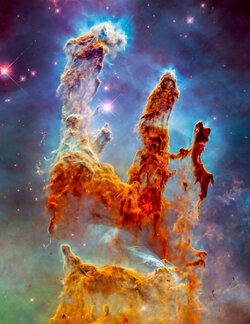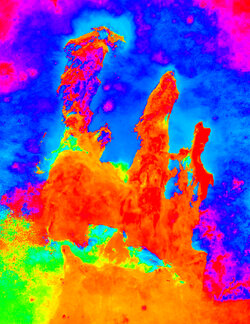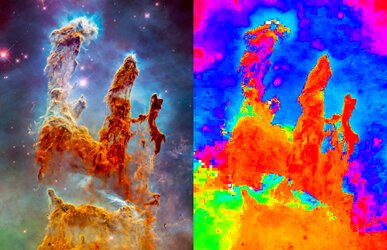thebestcpu
Guru
- Messages
- 3,189
- Likes
- 2,946
@ Rich54 asked how I created a Hue Map, so it was worth posting in the Actions, Filters, etc. Forum
In ancient times, I created some Actions that I used regularly. One was making a Hue Map (my definition, as I have not seen it anywhere online). It's where each pixel is converted to its maximum luminosity and maximum saturation while maintaining its Hue. This involves a process where all channels are scaled linearly until the maximum RGB value reaches "1" (or 255 of 8-bit mode) and then similarly where all channels are scaled linearly until the minimum RGB value is scaled down to "0" (0 in bit mode).
It has some math rounding limitations for bright and dark colors, especially in 8-bit mode, yet serves its purpose. My original Action called other dependent Actions, yet since that original Action, I have learned some tricks in adjustment Layers and blending modes that give a pretty good Hue map more efficiently.
Let me know if you come across any bugs. All you need to do is select that Layer from which you want a Hue Map created. I merge visible Layers to the initially selected Layer so it should leave all Layers undistrubed with one final added Layer labeled "Hue at Max Saturation"
I used to find issues in images, making selections and just for grins.
The Action is attached to this post.
As an example, here is an image of the pillars of creation and the associated Hue Map created with this Action
Pillars of Creation

Hue Map of Pillars of Creation

A version of Pillars of Creation is saved at low JPEG compression (10 out of 100) on the left, and the Hue Map shows highly compressed Pillars of Creation on the right.
This exposes the loss of detail in the Hue component of the image when highly compressed. The eye has low color resolution, so it does not see it yet. This can be a real problem when trying to post-process such highly compressed images as the JPEG artifacts can raise their heads.

Here is the ATN file for the Action and let me know if you find bugs
John Wheeler
In ancient times, I created some Actions that I used regularly. One was making a Hue Map (my definition, as I have not seen it anywhere online). It's where each pixel is converted to its maximum luminosity and maximum saturation while maintaining its Hue. This involves a process where all channels are scaled linearly until the maximum RGB value reaches "1" (or 255 of 8-bit mode) and then similarly where all channels are scaled linearly until the minimum RGB value is scaled down to "0" (0 in bit mode).
It has some math rounding limitations for bright and dark colors, especially in 8-bit mode, yet serves its purpose. My original Action called other dependent Actions, yet since that original Action, I have learned some tricks in adjustment Layers and blending modes that give a pretty good Hue map more efficiently.
Let me know if you come across any bugs. All you need to do is select that Layer from which you want a Hue Map created. I merge visible Layers to the initially selected Layer so it should leave all Layers undistrubed with one final added Layer labeled "Hue at Max Saturation"
I used to find issues in images, making selections and just for grins.
The Action is attached to this post.
As an example, here is an image of the pillars of creation and the associated Hue Map created with this Action
Pillars of Creation

Hue Map of Pillars of Creation

A version of Pillars of Creation is saved at low JPEG compression (10 out of 100) on the left, and the Hue Map shows highly compressed Pillars of Creation on the right.
This exposes the loss of detail in the Hue component of the image when highly compressed. The eye has low color resolution, so it does not see it yet. This can be a real problem when trying to post-process such highly compressed images as the JPEG artifacts can raise their heads.

Here is the ATN file for the Action and let me know if you find bugs
John Wheeler
